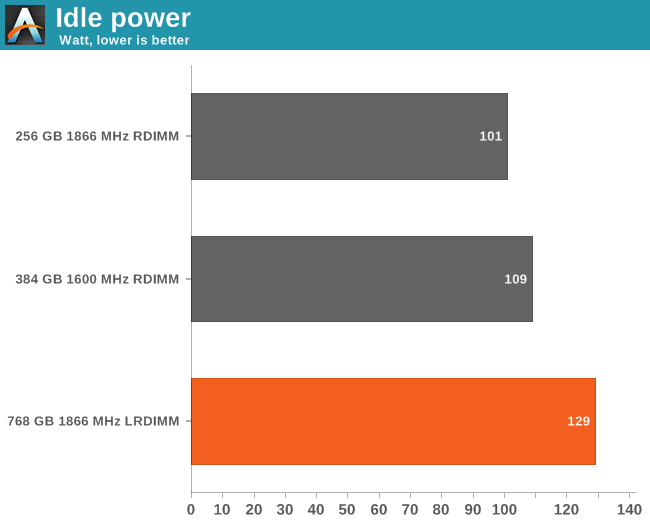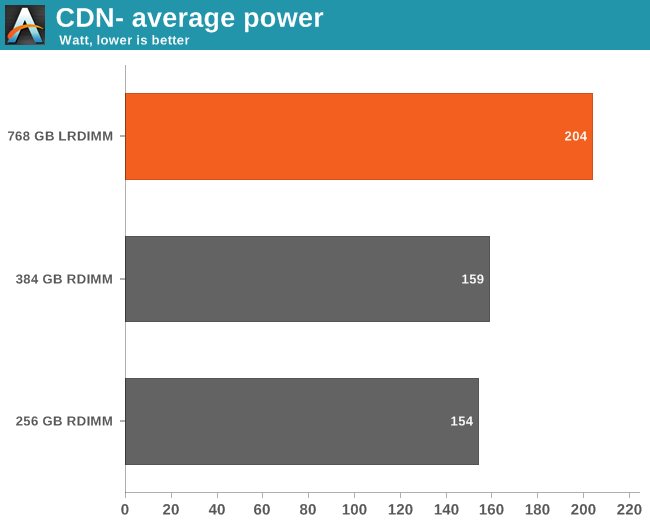Server Buying Decisions: Memory
by Johan De Gelas on December 19, 2013 10:00 AM EST- Posted in
- Enterprise
- Memory
- IT Computing
- Cloud Computing
- server
Evaluating Power
We start with the idle numbers.

The HP server consumes very little, about twice as much as a decent desktop at idle despite the 24 DIMMs and 20 physical cores. The LRDIMM iMB consumes about 1 additional Watt per DIMM. Next, let's look at the average power consumed during our CDN test.

The LRDIMM server consumes 45 Watts more, or about 28%. Note that this does not mean that LRDIMMs significantly increase the power consumption. The CPU is working quite a bit harder when running with 768GB RAM as it is able to get more out of the RAM cache instead of waiting for the disks.
Two RDIMM servers would require 320W, which is still a lot more than the 204W the HP 380 Gen8 consumed with 768GB.










27 Comments
View All Comments
subflava - Thursday, December 19, 2013 - link
Great article...look forward to more enterprise/IT professional based articles from Anandtech in the future. This is very timely for me as my company is just about to pull the trigger on a server upgrade. Interesting stuff.JohanAnandtech - Friday, December 20, 2013 - link
Thanks for sharing! :-)DERSS - Friday, December 27, 2013 - link
You guys are seriously super-cool; thanks.wsaenotsock - Thursday, December 19, 2013 - link
costed?blaktron - Thursday, December 19, 2013 - link
Good article, although as an enterprise architect, I can tell you the one true benefit to LRDIMMS is in 2 and 4 socket vhost builds, because the double density RAM gives you the freedom to turn off NUMA spanning and still get near-ideal guest density.Almost nobody runs caching servers that big, although at almost double performance over a 256GB build (the 100k + concurrent user norm) its kind of attractive to run 2 of these per DC instead of 6 smaller ones (which would actually be the real world comparison with those kind of deltas).
mexell - Thursday, December 19, 2013 - link
Real-world pricing, at least in the enterprise context, is quite a bit off from your numbers. In my employer's price bracket, we regularily buy similar servers as your 24*16GB config for about the same price (13k€) - but including a 3 year subscription VMWare Enterprise license, which is about 6 to 7 k€ on its own. No one pays list price on that kind of hardware.JohanAnandtech - Friday, December 20, 2013 - link
Are you sure that there is not a big discount on the VMware license? And smaller enterprises will pay something close to the list price. I know that the typical discount is 10-20% for smaller quantities, not more.blaktron - Friday, December 20, 2013 - link
Depends on the country Johan. The partner channel managers get to decide discounts on partner orders (which he is describing). Also, the bundling discount doesn't happen everywhere, but I could buy that server for like $15k CDN.The VMware license cost seems out of this world to me too, because we license our hosts for anyone from 2500 to 5k CDN, depending on their agreement with VMware.
mexell - Saturday, December 21, 2013 - link
I don't really know where exactly the discount is applied, as the licenses are OEM and we don't get line-item pricing. In our market segment (large enterprise with Dell, medium-to-large with HP) we usually see at least 40% off on list prices, in some cases (networking equipment) up to 75%.VMWare, on the other hand, is especially rigid with their pricing structure. Two years ago, when we negotiated for a 100 host branch office deployment, they referred to their list pricing. For them, we are not even big enough to speak directly to us.
dstarr3 - Thursday, December 19, 2013 - link
Wow. With 768GB of memory, I bet you could run Crysis.